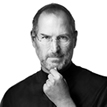In 1983, I touched one of the first Macintosh computers that Apple shipped. The technology editor at Newsweek at the time, Bill Marbach, let me open the box because he knew how besotted by technology I was.
 I remember my sheer wonder and joy at its user friendliness. I couldn’t believe how easy it was to process your work on a Mac. The mouse left me in awe, and I knew then that Steve Jobs must be a genius.
I remember my sheer wonder and joy at its user friendliness. I couldn’t believe how easy it was to process your work on a Mac. The mouse left me in awe, and I knew then that Steve Jobs must be a genius.
I was already a fan of all things Apple, having used a IIE. I shared my excitement about the Macintosh with two friends then who loved computers as much as I did, Joel Dreyfuss, now Managing Editor of the online magazine The Root, and Stephen Miller, the only computer guru I knew in those days and now an Assistant Professor at Columbia University’s Graduate School of Journalism.
I had understood what Apple was trying to do the moment years before when I read that Steve Wozniak, Jobs’ partner, had said that a computer was a tool for tasks so consumers didn’t need a complete grasp of the technology.
Panmedia started in an Apple environment in 1996. For our first few years, however, all our machines were bought second hand from Andrew Diaz of Visionary Computing and Andrew Levy of JIIC. We only allowed PCs in because our programmers preferred those clunky machines.
I have worked on nearly every Apple computer model, and I have owned only their laptops. Panmedia still has several old Apple computers that we refuse to discard. We keep them as displays for their bold designs, and the way they changed computing is still a comfort to us.
More recently, I embraced the iPod, the iPhone, the iPad and Apple TV, and plan to experiment with every new technology this innovative company introduces.
But now future memories Apple’s new products create will be missing the aura of Steve Jobs embedded in all their technology to date.
Knolly Moses
